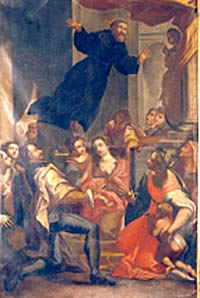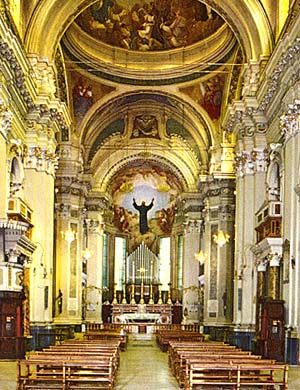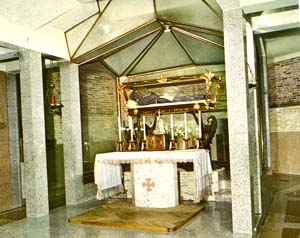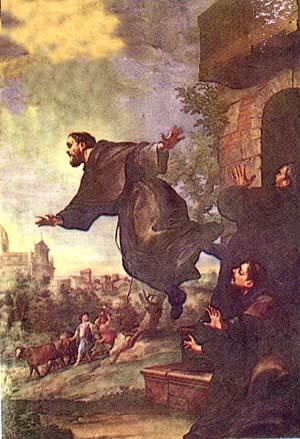St. Joseph of Cupertino, The Flying Frier
Saint Joseph of Cupertino Born: San Giuseppe da Copertino in Italy, (June 17, 1603 – September 18, 1663)t. He was said to have been remarkably unclever, butprone to miraculous levitation and intense ecstatic visions.
He is recognized as the patron saint of air travelers, aviators, astronauts, and people with a mental handicap, test takers, and weak students. He was canonized in the year 1767.
As a child, Joseph was slow witted. He loved God a lot and built an altar. This was where he prayed the rosary. He suffered from painful ulcers during his childhood. After a hermit applied oil from the lamp burning before a picture of Our Lady of Grace, Joseph was completely cured from his painful ulcers.
When he was 17, Joseph attempted to join the Friars Minor Conventuals, but his lack of education prevented him from gaining admittance. He was soon after admitted as a Capuchin, but removed from the order shortly thereafter when his constant fits of ecstasy proved him unsuitable.
Eventually, in his early twenties, he was admitted into a Franciscan friary near Cupertino. He had a learning disability. According to believers, Joseph could barely read or write, but continued to grow in holiness and wisdom, leading a life of poverty and prayer. He was unsuited for scholarship, but could answer intricate questions. He also performed menial tasks around the friary, such as gardening, looking after the animals, cleaning their stalls, and helping in the kitchen. Joseph was also often found wandering in a daze, winding up in different places in the friary unaware of how he got there.
When he was a candidate for deacon, the bishop at random asked Joseph to expound on the text “Blessed is the womb that bore thee.” He did well. Thus he was ordained deacon. When it was a question of the priesthood, the first candidates did so well that the remainder of the candidates, Joseph among them, were passed without examination and Joseph was ordained a priest in 1628.
 On October 4, 1630, the town of Cupertino held a procession on the feast day of Saint Francis of Assisi. Joseph was assisting in the procession when he suddenly soared into the sky, where he remained hovering over the crowd. When he descended and realized what had happened, he became so embarrassed that he fled to his mother’s house and hid.
On October 4, 1630, the town of Cupertino held a procession on the feast day of Saint Francis of Assisi. Joseph was assisting in the procession when he suddenly soared into the sky, where he remained hovering over the crowd. When he descended and realized what had happened, he became so embarrassed that he fled to his mother’s house and hid.
His flights continued and came with increasing frequency. His superiors, alarmed at his lack of control, forbade him from community exercises, believing he would cause too great a distraction for the friary. On hearing the names of Jesus or Mary, the singing of hymns, during the feast of St. Francis, or while praying at Mass, he would go into dazed state and soar into the air, remaining there until a superior commanded him to come down.
Joseph’s most famous flight allegedly occurred during a papal audience before Pope Urban VIII. When he bent down to kiss the Pope’s feet, he was suddenly filled with reverence for Christ’s Vicar on earth, and was lifted up into the air. Only when the Minister General of the Order, who was part of the audience, ordered him down was Joseph able to return to the floor.
Joseph gave off a sweet smell because he was pure. Joseph could also smell the bad odor of a sinful person. When they would come, sometimes he would tell them that they stank and that they should go wash themselves. By this, he meant for them to go to confession.
On August 10, 1663, Joseph became ill with a fever, but the experience filled him with joy. When asked to pray for his own healing he said, “No, God forbid” He experienced ecstasies and flights during his last mass which was on the Feast of the Assumption. In early September, Joseph could sense that the end was near, so he could be heard mumbling, “The jackass has now begun to climb the mountain!” The ‘jackass’ was his own body. After receiving the last sacraments, a papal blessing, and reciting the Litany of Our Lady, Joseph Desa of Cupertino died on the evening of September 18, 1663.
He was buried two days later in the chapel of the Immaculate Conception before great crowds of people.
Joseph was canonized on July 16, 1767, by Pope Clement XIII. In 1781, a large marble altar in the Church of St. Francis in Osimo was erected so that St. Joseph’s body might be placed beneath it; it has remained there ever since.
The Flying Frier

The Basilica of St. Joseph of Cupertino in Osimo, Italy, which houses the Saint’s body.

The Saint’s body can be venerated in a Sanctuary altar under the Basilica



.jpg)
